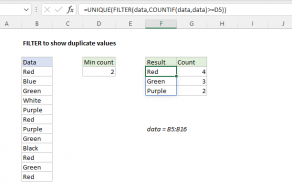Explanation
This example uses the UNIQUE function together with the FILTER function. You can see a more basic example here.
The trick in this case is to apply criteria to the FILTER function to only allow values based on the count of occurrence. Working from the inside out, this is done with COUNTIF and the FILTER function here:
FILTER(data,COUNTIF(data,data)>1)
The result from COUNTIF is an array of counts like this:
{3;1;3;3;2;1;1;3;1;2;3;3}
which are checked with the logical comparison > 1 to yield an array or TRUE/FALSE values:
{TRUE;FALSE;TRUE;TRUE;TRUE;FALSE;FALSE;TRUE;FALSE;TRUE;TRUE;TRUE}
Notice TRUE corresponds to values in the data that appear more than once. This array is returned to FILTER as the include argument, used to filter the data. FILTER returns another array as a result:
{"red";"green";"green";"blue";"red";"blue";"red";"green"}
This array is returned directly to the UNIQUE function as the array argument. Notice of the 12 original values, only 8 survive.
UNIQUE then removes duplicates, and returns the final array:
{"red";"green";"blue"}
If values in B5:B16 change, the output will update immediately.
Count > 2
The formula in F5, which lists colors appearing at least 2 times in the source data, is:
=UNIQUE(FILTER(data,COUNTIF(data,data)>2))
Dynamic source range
Because data (B5:B15) is a normal named range, it won't resize if data is added or deleted. To use a dynamic range that will automatically resize when needed, you can use an Excel Table, or create a dynamic named range with a formula.
Dynamic Array Formulas are available in Office 365 only.
















